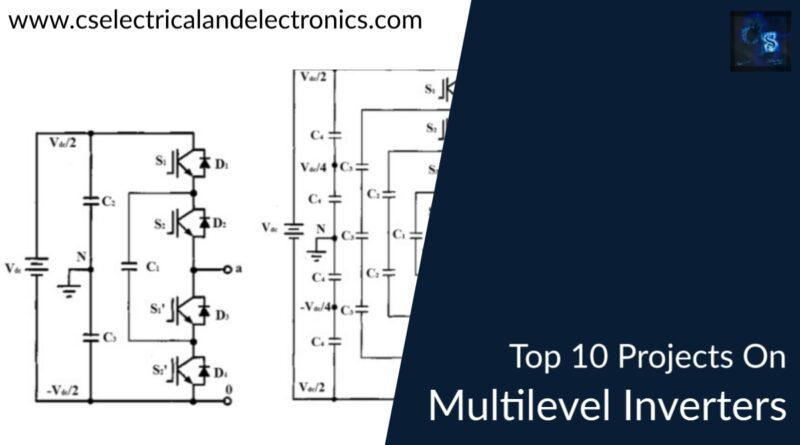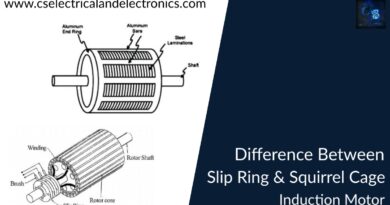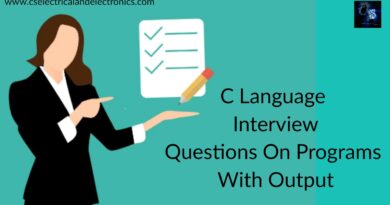Top 10 Projects On Multilevel Inverters For MTech, Engineers
Hello guys, welcome back to our blog. Here in this article, we will share the top 10 projects on multilevel inverters for MTech, & engineering students, an introduction to each project, and which will be the best project.
If you have any electrical, electronics, and computer science doubts, then ask questions. You can also catch me on Instagram – CS Electrical & Electronics.
Also, read:
- CAN Protocol Tutorial, Working, Frames, Interview Q’s, Errors
- Top 16 Robots That Will Change The World, Humanoid Robots
- What Are Parasitic Capacitance And Inductance, Causes, Avoid
Projects On Multilevel Inverters
10. Performance Evaluation Of Single Stage Grid-Integrated Solar PV System With Reduced DC-bus Capacitor Based On Three Phase NPC
The DC-bus capacitor size of a traditional three-phase neutral point clamped (NPC) inverter-based single-stage grid-integrated solar photovoltaic (PV) system is proposed to be effectively reduced in this work. A metalized polypropylene film DC-bus capacitor has been used in place of an electrolytic capacitor to achieve this.
As a result, the system becomes more long-term reliable, costs are decreased, and the system lives longer. Also noted is the modest DC-bus capacitor’s contribution to the unbalances in capacitor voltage. A carrier-based modified modulation approach is used as a fix to enhance the neutral-point voltage’s dynamic response.
In order to harvest solar PV electricity, an optimal power extraction (OPE) strategy is used. Minimal oscillations are seen, and the DC-bus voltage overshoot problem that develops during the shift in irradiation is fixed. The developed system enables the three-phase grid to receive the extracted power via the NPC converter, reducing the grid’s total harmonic distortion (THD).
The voltage and current error are reduced using the PI controller. A simulation model for MATLAB is used to monitor system performance, and the experimental data from the lab prototype is used to verify it.
09. Multilevel Converter For Solar Photovoltaic System Integration With Nearest Level Control
This study introduces a novel solar photovoltaic (PV) system for medium voltage applications based on the Scott-ternary solar multilevel converter (ST-MLC). This system uses two voltage source converters (VSCs) to serve a three-phase grid and one solar PV array as an input source. From a two-phase to a three-phase medium voltage grid with balanced grid currents, solar electricity is fed.
Two-phase systems are created by cascading the legs of VSCs. A nine-level three-phase power conditioning system is created by connecting the multi-winding transformers in a Scott fashion. For the generation of higher levels, the transformers’ turn ratios follow a ternary progression.
A closed-loop nearest-level control approach is included in the system modeling that is offered in order to have minimal losses. The performance of the solar PV system under steady-state and dynamic irradiance is demonstrated by simulation results. On the basis of the geographical information system’s daily average global solar irradiation for New Delhi, India, varying solar profiles are taken into account.
For the converter voltage and grid current, the harmonic performance is examined. Additionally, a thorough comparative analysis is provided to assess the ST-superiority MLCs over its existing competitors. The control and functioning of the massive solar PV system are verified by performance validation on a real-time test bench.
08. Grid-Tied Multi-Port System With Integrated PV And Battery Storage: Model Predictive Control
The integrated photovoltaic (PV) and battery storage system is proposed in this project as a unified model predictive control (MPC) scheme, with both of them being directly connected to the utility grid with high conversion efficiency through a multi-level neutral-point-clamped (NPC) inverter based multi-port interface.
Asymmetric voltage vector distribution and greater modulation complexity on the AC side occur from the system’s individual/unequal input voltage from each DC port, which poses control issues. The suggested finite-control-set MPC (FCS-MPC) strategy, which takes advantage of the direct control property without the use of a modulator, enables power management to be freed from the modulator design in this situation.
In order to comply with IEEE 519-2014, the multivariable-based cost function is made for the AC side and is intended to control the injected grid current effectively. On the other hand, to continue with the typical DC-side power flow, the unified cost function in the MPC framework is used to model, predict, and regulate the capacitor voltage of each port.
As a result, each PV array can operate at its own maximum power point (MPP), and the battery can be charged or drained automatically to make up for any power imbalances. To demonstrate the benefits of the suggested controller and the multi-mode operation of the integrated system, three-level dual-port inverter-based experimentation and simulation are used.
07. A Novel Seven-level Inverter With Embedded Voltage Boosting For Applications Involving Renewable Energy
The revolutionary seven-level inverter for renewable energy applications proposed in this study has the potential to raise the voltage. The suggested inverter is built on the foundation of a full-bridge (FB) inverter, whose two half-bridge legs are each connected to a three-level T-type (3LTT) inverter through a cascaded arrangement.
It receives power from one dc source connected in series with an input inductor. Without the need for additional switches, the FB inverter internally charges the inductor from the dc source. Following that, energy is transferred to capacitors that directly power the 3LTT inverters. Since each capacitor can be charged by the inductive dc-link with the same step-up average voltage, auxiliary circuits for balancing the voltages of capacitors are not necessary.
The proposed inverter’s functioning principles are outlined. Analyzed and compared with those of prior-art systems are important inverter metrics like voltage gain and voltage pressures on electronics. The suggested single-stage dc-to-ac power conversion is capable of providing a boosted seven-level output voltage with relatively high efficiency, according to simulations and experimental data.
06. A Three Phase Cascaded H Bridge Based Photovoltaic Generation System Grid Frequency Support Control Strategy
Photovoltaic (PV) generating is now a viable solution to the energy crisis and environmental pollution issues because of benefits like being clean and secure. The PV inverter, however, lacks inertia and damping properties. Grid frequency stability has been severely hampered by large-scale PV grid connections due to the rising penetration of PV energy into the electricity system.
A possible alternative for the PV generation system, the Cascaded H-bridge (CHB) inverter provides features including a modular design and direct grid connection without power frequency transformers. This study suggests an inverter control method with a grid frequency support function for three-phase CHB-based PV generation systems.
Grid frequency dynamic characteristics without energy storage devices are improved with the PV string active power reserve. With the reserved power distribution control between PV strings suggested in this research, the common module power unbalance problem for the CHB architecture is resolved by balancing the output power of the PV string.
It is possible to produce a balanced three-phase grid-connected current output while optimizing the input power balance of the H-bridge inverter. H-bridge modules have less of a chance of over-modulation. Finally, Matlab/Simulink simulation models are created, together with a 10kW experimental platform. Results from modeling and experimentation support the effectiveness of the proposed control technique.
05. A New Single-Source Nine-Level Quadruple Boost Inverter For Solar Applications
Due to its use in AC high-voltage applications and the field of renewable energy, multi-level inverters (MLIs) with switched capacitors are growing in popularity. The switched capacitor (SC) technique uses fewer DC sources in line with the voltage across the capacitor to produce the needed magnitude of output voltage.
It takes significant work to design an effective high-gain MLI with fewer sources and switches. In contrast to earlier SC-MLIs topologies, the nine-level quadruple boost inverter (NQBI) design shown in this study uses fewer capacitors, switches, and diodes and is powered by a single solar photovoltaic source.
The recommended NQB inverter effectively balances the voltages of the two capacitors to provide nine levels of voltage in its output. To demonstrate the advantages and disadvantages of the suggested nine-level quadruple boost inverter (NQBI) topology, various SC-MLIs are contrasted. Detailed experimental results are presented in a laboratory environment under various test settings to validate the effectiveness of the proposed solar photovoltaic-based NQBI without a grid connection.
04. An All-purpose High Gain Multilevel Inverter For Small-Scale Solar Photovoltaic Applications
In the energy sector, renewable energy, particularly small-scale solar photovoltaics (PV), is contributing exponentially more. The low voltage of PV panels is typically increased using high-gain DC-DC converters as front-end converters; moreover, DC-AC converters (multilevel inverters) are employed for stand-alone AC loads or grid integration.
This research suggests a nine-level quadruple boost inverter topology for small-scale solar PV applications to bypass the front-end converter and fulfill both goals. The proposed design has self-voltage balancing capacitors and boosts voltage using a switched capacitor approach. In this work, the suggested nine-level inverter’s comprehensive operation, voltage stress calculations, loss analysis, and circuit parameter designing are covered.
It is also reported on a high-gain generalized multilevel inverter (MLI) topology. The suggested MLI is also contrasted with competing inverters found in current academic publications. A low total standing voltage and a smaller number of components are two benefits of the proposed MLI topology, which can also naturally produce bipolar voltage.
Through MATLAB-based simulations and an experimental prototype, the performance of the suggested MLI topology is confirmed. The experimental findings are also provided while taking the load, modulation index, and output frequency fluctuations into account. For the suggested 9-level inverter, the experimental efficiency is in the range of 96.2% to 92.8%.
03. A 3-Level Single Stage A-Source Inverter With Shoot-Through State Active Voltage Vector Generation
Impedance network (IN) inverters are a desirable option for DC/AC applications with low input DC voltage due to their single-stage boosting capacity. To obtain the requisite voltage gain, a particular duration of shoot-through (ST) condition is needed. It is customary to apply the ST state and zero output voltage vector simultaneously.
Especially for applications requiring a large boosting factor, this restriction reduces the modulation index and raises the voltage stress on semiconductor devices. A newly modified configuration of A-source IN with two series outputs is proposed in this work and coupled to a 10-switches three-level inverter as the boosting stage for a three-level inverter.
The suggested DC/AC inverter is able to apply an active voltage vector during the ST stage in addition to producing two outputs from a single IN. This feature reduces the necessary ST time, boosts the modulation index, and enhances DC/AC voltage gain. The steady-state relations are developed, and the operating principles are given.
Its boost factor and switch voltage stress are compared to those of other magnetically coupled INs. A maximum boost method utilizing space vector modulation is created with the 10-switches, a three-level inverter as the front-end inverter, and it is designed to aim for the shortest ST time. Finally, a converter prototype is created in a lab and put through a number of tests. The findings support the aforementioned ideas and simulations.
02. One Supply Three-phase Two-level inverter And Two single-phase Cascaded h-bridge Inverters Are Combined To Form A Three-phase Multilevel Inverter.
Compact, less expensive, and more efficient multilevel inverters (MLIs) include fewer switching components and dc sources. In this article, a single-source MLI based on transformers is suggested, with fewer components and smaller transformers.
The suggested architecture is a hybrid three-phase MLI made up of two single-phase cascaded H-bridge inverters and a traditional three-phase two-level inverter (TTI) (CHBIs). The ratio of active switches to output voltage levels is low in the proposed MLI. The TTI and CHBI are cascaded with transformers such that only one dc source is needed. To manage the voltage of this inverter, an individual nearest level modulation (NLM) has been devised.
Additionally, an analysis of its module power distribution is performed. The transformers’ combined power is 28% of the inverter’s rated power. The 13-kVA prototype’s simulation and experimental findings attest to the effectiveness of the suggested configuration.
01. A Contactless Power Transfer System With A Multilevel Inverter
Voltage-source inverters are frequently employed in contactless power transfer (CPT) systems with a resonant tank. The primary resonant frequency, however, varies due to the impact of the working environment, aging, and other factors.
Additionally, the design of a resonant tank with a constant switching frequency may be impacted by the secondary coil’s reflected equivalent impedance. This brief suggests a multilevel inverter (MLI) for the CPT system without resonant circuit tuning.
The suggested inverter can generate a high-frequency ac voltage with a primary coil envelope that is approximatively sinusoidal. Low-order harmonics can be removed by choosing an acceptable input voltage ratio and switching angles for the switches, according to the equation created for the inverter.
Additionally, by using multilevel circuits, it is possible to achieve the cancellation of numerous harmonics. Low voltage stress, good dependability, and a reduction in low-order harmonics are all benefits of the proposed MLI. To confirm the effectiveness of the suggested MLI, hardware testing results were obtained for a CPT system prototype.
This was about “Projects On Multilevel Inverters“. I hope this article may help you all a lot. Thank you for reading.
Also, read:
- 10 Tips To Maintain Battery For Long Life, Battery Maintainance
- 10 Tips To Save Electricity Bills, Save Money By Saving Electricity
- 100 (AI) Artificial Intelligence Applications In The Automotive Industry
- 100 + Electrical Engineering Projects For Students, Engineers
- 1000+ Control System Quiz, Top MCQ On Control System
- 1000+ Electrical Machines Quiz, Top MCQs On Electrical Machines
- 1000+ MATLAB Simulink Projects For MTech, Engineering Students
- 50 Tips To Save Electricity At Home, Shop, Industry, Office
Author Profile
- Chetu
- Interest's ~ Engineering | Entrepreneurship | Politics | History | Travelling | Content Writing | Technology | Cooking
Latest entries
 All PostsApril 29, 2024Top 11 Free Courses On Battery For Engineers With Documents
All PostsApril 29, 2024Top 11 Free Courses On Battery For Engineers With Documents All PostsApril 19, 2024What Is Vector CANoe Tool, Why It Is Used In The Automotive Industry
All PostsApril 19, 2024What Is Vector CANoe Tool, Why It Is Used In The Automotive Industry All PostsApril 13, 2024What Is TCM, Transmission Control Module, Working, Purpose,
All PostsApril 13, 2024What Is TCM, Transmission Control Module, Working, Purpose, All PostsApril 12, 2024Top 100 HiL hardware in loop Interview Questions With Answers For Engineers
All PostsApril 12, 2024Top 100 HiL hardware in loop Interview Questions With Answers For Engineers








